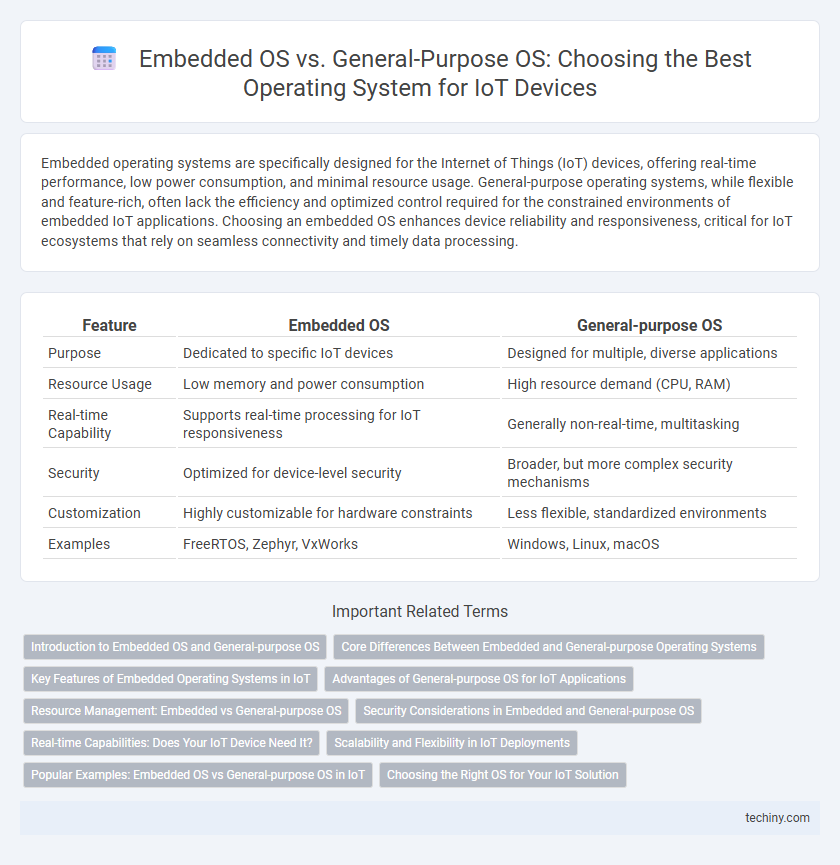Embedded operating systems are specifically designed for the Internet of Things (IoT) devices, offering real-time performance, low power consumption, and minimal resource usage. General-purpose operating systems, while flexible and feature-rich, often lack the efficiency and optimized control required for the constrained environments of embedded IoT applications. Choosing an embedded OS enhances device reliability and responsiveness, critical for IoT ecosystems that rely on seamless connectivity and timely data processing.
Table of Comparison
| Feature | Embedded OS | General-purpose OS |
|---|---|---|
| Purpose | Dedicated to specific IoT devices | Designed for multiple, diverse applications |
| Resource Usage | Low memory and power consumption | High resource demand (CPU, RAM) |
| Real-time Capability | Supports real-time processing for IoT responsiveness | Generally non-real-time, multitasking |
| Security | Optimized for device-level security | Broader, but more complex security mechanisms |
| Customization | Highly customizable for hardware constraints | Less flexible, standardized environments |
| Examples | FreeRTOS, Zephyr, VxWorks | Windows, Linux, macOS |
Introduction to Embedded OS and General-purpose OS
Embedded operating systems (OS) are designed specifically for managing hardware and software resources in Internet of Things (IoT) devices, prioritizing real-time performance, low power consumption, and limited memory usage. General-purpose operating systems (GPOS) like Windows or Linux provide broad functionality and support for multiple applications but are often too resource-intensive for constrained IoT environments. Embedded OS examples include FreeRTOS and Zephyr, optimized for sensor integration and real-time data processing in smart devices.
Core Differences Between Embedded and General-purpose Operating Systems
Embedded operating systems are specifically designed for resource-constrained devices in the Internet of Things, offering real-time performance, minimal memory usage, and dedicated functionality. In contrast, general-purpose operating systems prioritize versatility and user interaction, supporting a wide range of applications with substantial memory and processing requirements. Core differences include deterministic response times in embedded OS versus multitasking and comprehensive feature sets in general-purpose OS.
Key Features of Embedded Operating Systems in IoT
Embedded operating systems in IoT devices prioritize real-time performance, low power consumption, and minimal memory footprint to ensure efficient and reliable operation within constrained hardware environments. These OSs support specialized communication protocols and provide robust security features to safeguard data integrity and privacy across interconnected devices. Unlike general-purpose operating systems, embedded OSs offer deterministic task scheduling and optimized resource management tailored for specific IoT applications.
Advantages of General-purpose OS for IoT Applications
General-purpose operating systems offer extensive hardware compatibility and a broad range of software support, making them ideal for diverse IoT applications. They provide robust security features and regular updates, ensuring devices remain protected against evolving cyber threats. Their flexibility allows developers to implement complex functionalities and integrate with cloud services seamlessly, enhancing overall IoT ecosystem performance.
Resource Management: Embedded vs General-purpose OS
Embedded operating systems optimize resource management by using minimal memory and processing power tailored for specific IoT hardware constraints, ensuring real-time performance and low latency. General-purpose OS manage resources with broader hardware compatibility and multitasking capabilities but consume higher CPU and memory resources, which may lead to inefficiencies in resource-constrained IoT devices. Efficient resource allocation in embedded OS enhances battery life and device responsiveness, critical for sustainable and reliable IoT deployment.
Security Considerations in Embedded and General-purpose OS
Embedded operating systems prioritize security through minimal attack surfaces and real-time capabilities, limiting vulnerabilities in IoT devices by running only essential functions. General-purpose operating systems face greater security challenges due to complex software stacks and broader compatibility requirements, increasing exposure to malware and unauthorized access. Secure boot, sandboxing, and regular patching are critical strategies in both OS types to protect sensitive IoT data and maintain device integrity.
Real-time Capabilities: Does Your IoT Device Need It?
Embedded OS offers deterministic real-time capabilities essential for IoT devices requiring precise timing and low-latency responses, such as industrial automation and medical monitoring systems. General-purpose OS, like Linux or Windows, prioritize multitasking and user experience but often lack guaranteed real-time performance, making them less suitable for time-critical IoT applications. Choosing the right OS depends on the IoT device's real-time processing needs, where embedded OS ensures reliability and predictability in mission-critical environments.
Scalability and Flexibility in IoT Deployments
Embedded operating systems in IoT devices offer superior scalability by efficiently managing limited hardware resources and enabling real-time processing for sensor networks. General-purpose OS provide greater flexibility with broader application support and easier integration of diverse protocols but may introduce latency and higher power consumption. Choosing between the two depends on balancing the need for optimized performance in constrained environments against versatility in complex IoT deployments.
Popular Examples: Embedded OS vs General-purpose OS in IoT
Embedded operating systems like FreeRTOS and Contiki are optimized for resource-constrained IoT devices, offering real-time performance and low power consumption. In contrast, general-purpose operating systems such as Linux and Windows IoT provide extensive hardware support and scalability but require more memory and processing power. Selecting between embedded OS and general-purpose OS in IoT applications depends on device capabilities and specific real-time requirements.
Choosing the Right OS for Your IoT Solution
Embedded operating systems are tailored for real-time performance, low power consumption, and efficient resource management, making them ideal for IoT devices with specific, constrained functions. General-purpose operating systems offer extensive features, broad hardware compatibility, and easier development environments but may consume more power and resources, posing challenges for battery-operated IoT applications. Selecting the right OS depends on the device requirements, performance needs, and power constraints inherent in the target IoT deployment.
Embedded OS vs General-purpose OS Infographic

 techiny.com
techiny.com